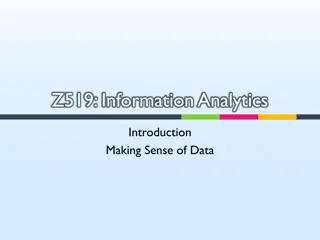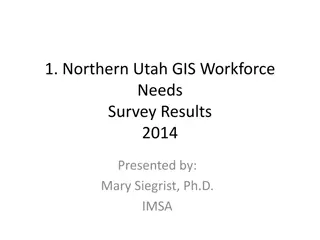Improving Data-driven Decision Making in Utah's Human Services Division
Utah's Department of Human Services Division of Services for People with Disabilities is utilizing National Core Indicators (NCI) data to identify areas of improvement, create benchmarks, and enhance decision-making processes. Through the NCI Dashboard, stakeholders provide feedback, enabling better visualization and comparison of Utah's performance with other states. Future considerations include enhancements like an interactive print option, family surveys, and additional measures for better insights and policy-making.
Download Presentation

Please find below an Image/Link to download the presentation.
The content on the website is provided AS IS for your information and personal use only. It may not be sold, licensed, or shared on other websites without obtaining consent from the author.If you encounter any issues during the download, it is possible that the publisher has removed the file from their server.
You are allowed to download the files provided on this website for personal or commercial use, subject to the condition that they are used lawfully. All files are the property of their respective owners.
The content on the website is provided AS IS for your information and personal use only. It may not be sold, licensed, or shared on other websites without obtaining consent from the author.
E N D
Presentation Transcript
National Core Indicators State of Utah Department of Human Services Division of Services for People with Disabilities
How does Utah use NCI Data? Workgroup: Group identified four areas of improvement based on the Adult Consumer Survey Report. Benchmarks were created and initial brainstorming began. Areas included: Employment Choice in living setting Health and safety in home/work/day program environments Health: Annual physical exams Legislative Reporting: Funding requests to serve people on the waiting list Direct support staff wage increases (Staff Stability Survey) Legislative performance measures
NCI Dashboard Link: https://dspd.utah.gov/dashboard/national-core-indicators/
Feedback The dashboard was shared with Division staff, stakeholders, families, contracted providers, and the Division s advisory council. Feedback was requested in areas of functionality, strengths and weaknesses of the dashboard, value, and clarity. Strengths of Dashboard: Visual comparison between Utah and other states (Map) Comparison between Utah and Nation Colors, Utah is easily identified. Nice visualization when looking at all the states Weaknesses of Dashboard: Difficult to understand for people not familiar with NCI Doesn t answer questions for people unfamiliar with how data was collected How do you collect responses from someone who is non-verbal How do you validate the data Switching measures that are under a different indicator renders a Data Unavailable warning Data Not all states participate each year Just data, no analytics
Feedback Value of Dashboard: Stakeholders/Legislators can see where Utah ranks with other states Division staff can use in a variety of reports, particularly those including state case studies Gives support to families and stakeholders when discussing areas of concern with the Division Quality assurance staff can use this information in contact reviews with providers Uses: (Not included above) Visualizations for presentations to stakeholders and legislators Policy writing
Future Considerations Print or Save image option. The dashboard is designed to be interactive but having these options is also a good idea Include family surveys Include a citation if printing or saving image. Also include a link to the full citation Using a measure as a filter (Only an option for Utah because of the granularity of the data needed) Secondary dashboard looking at both the primary and secondary measure Link to NCI website to answer questions about NCI or a link to a document that explains the survey, data collection, validating the data, etc. Another dashboard that has measures that Utah is significantly above or significantly below the NCI average
Questions? Email: cmidgley@utah.gov Dashboard: https://dspd.utah.gov/dashboard/national-core-indicators/






















